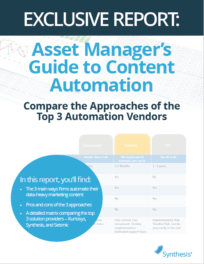Fund Data Automation Solves Four Common Data Problems Faced by Fund Marketers
A few common phrases we hear from investment marketers are, Our financial data is a bit of a mess and Our data could use a little housekeeping. In our experience, we have learned that marketers have become the de facto experts on fund data management and automation.
Fund marketers themselves are routinely chasing-down their financial data from many disparate sources, both internal and external. Then, they are trying to extract clean data for use in their customer-facing marketing materials. This process is made more challenging when there are tight time frames. Plus, it has to be done with the highest levels of accuracy and consistency in real-time.
There are many common data issues fund marketers experience when preparing fund data for building factsheets, performance reports, and other marketing documents. Fund data management systems can address each of these common data issues, as well as provide other benefits to investment marketing teams.
When loading financial data through an automated process or a dedicated fund data management system, certain validations and checks can be put in place to reduce and even eliminate many of these data issues. Here are four common data problems faced by fund marketers:
1. Data Is Missing
The phrase “static data” is often used in regard to fund data. This is laughable, because fund data, in general, is anything but static. Fund names change. Fund-to-benchmark mappings change. New funds are launched while others are closed. These events and others often cause issues in data sources and reports used by fund marketers for document production. To the fund marketer preparing documents at quarter-end, having data go missing and simply “popping off” of the data source is alarming and slows down document production.
When data is missing from a source file, it may get noticed by someone and a resolution cycle can begin. Other times, it may go unnoticed, causing problems in the documents. In all cases, missing data is a source of frustration for marketers when their minds are on producing documents rather than QA’ing data.
How fund data automation solves it
When using a data automation system to manage fund data, the problem of missing financial data can be located and identified, and rectified before the fund marketer needs it for production. Data automation systems can perform a number of validations or checks on the data as it is loaded. For example, the system can be configured to look for expected patterns. A simple example of this is to look for expected headings and values. Also, it can provide a notification when data appeared last month but didn’t appear this month. And all of this is managed by the data source owner – not the fund marketer!
2. Fund Data Is Confusing
Unexpected or confusing data is another common issue, especially with files that are manually created or modified. Data files coming in with redundant data is a common use case. For example, performance for a fund may come in twice or more in the same file. When this happens, the performance numbers are sometimes different. It’s difficult to determine which is valid. Also, the format of the financial data may differ, causing confusion and aggravation for the fund marketer.
How fund data automation solves it
In this case, a data automation system can be used to perform various checks and validations against the data. For example, a check may be put in to notify the data owner if a data point is provided more than once. Similarly, if the source data format doesn’t match, a notification can be sent back to the owner for the appropriate resolution.
3. The Data Isn’t Mapped Correctly
Incorrect mapping is one of the most commonly faced data issues by fund marketers. This is typically an issue when name changes occur, a fund launches or closes, benchmarks change, etc… This can happen at the strangest of times because data files rely heavily upon mapping. With so many disparate sources, there are many different mapping values for the same particular data item. For example, a fund may be referenced by its CUSIP, ticker, or internal identifiers. Switching between the different mapping values is cumbersome and problematic. This is especially true when doing so manually or using Excel VLOOKUP and INDEX/MATCH functions.
How fund data automation solves it
With a data automation system in place, mapping values can be programmed and maintained easily. When mapping values don’t match, notifications go to the responsible parties prior to marketing involvement. In addition, when a new mapping key appears for which a corresponding mapping value doesn’t exist, an “action required” notification is sent to the interested parties. This lifts a heavy burden lifted off of the marketing team.
Related White Paper: 8 Data Best Practices for Investment Managers
4. Performance Values Don’t Add Up
Have you ever seen a pie chart with values that add up to over 100%? This happens far too often. In many cases, it is simply dealt with by adding some disclosure text stating that funds may not add up to 100%. Another example of bad financial data is a simple misplacement of a decimal place. This happens more commonly in a manually created or modified source file. However, it could also happen in a data file that underwent some coding or procedural changes.
How fund data automation solves it
Data validation checks-in-place ensure specific data types are checked for summation tolerances. In the case of the misplaced decimal place, a tolerance +/- check can be put into place. For example, your data management provider can tell the system to flag any performance values that are +/- more than 25%. That may be a large enough swing in a single quarterly period to flag a potential mistake.
Infographic: How to get clean data for fund marketing.

Chasing down data and getting it in a clean and usable format for marketing can be daunting. But it doesn’t have to be. With a feature-rich data management system in place, you can save time and have confidence in your numbers across all your sales and marketing materials.
Here are some related resources that might interest you:







 Compare the Top 3 Finserv Content Automation Vendors [White paper]
Compare the Top 3 Finserv Content Automation Vendors [White paper] Create Pitchbooks the Drive Sales [White paper]
Create Pitchbooks the Drive Sales [White paper] Build vs. Buy: Should Your Financial Services Firm Outsource or Insource Marketing Technology? [White paper]
Build vs. Buy: Should Your Financial Services Firm Outsource or Insource Marketing Technology? [White paper]  10 Tips for Rebranding your Fund Marketing Documents [White paper]
10 Tips for Rebranding your Fund Marketing Documents [White paper]




